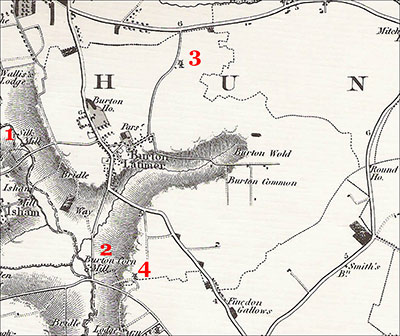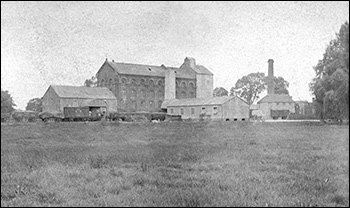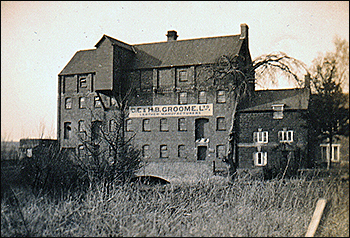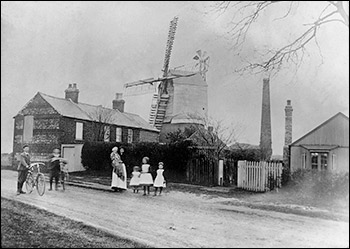| Article by John Meads, 2005, amended 2017 | ||||||||
|
||||||||
|
||||||||
|
The Priory of Bradenstoke (Wilts) had property in Burton Latimer by 1222, including a mill called “Byggemull” (big mill?). A pre-1234 document at the National Archives records a grant of 40 shillings rent owed by Aubrey de Burtoun from the mill of Burtoun (Burton Latimer) but it is unclear to which of the two water mills these refer. Click to read about Burton and Isham Mills to Let
In 1928 both T & J Wallis Ltd. and Whitworth Bros. were shown as millers at Burton Latimer but soon afterwards the mill was disused. About 1932 four businessmen, Bennison Osborne, an Australian; Malcolm Macfarlane, a New Zealander; Arthur Scrutton and Alfred Upton set up the British & South Africa Cereal Company Ltd, to market a product they called Weetabix and which they had been selling in Click here to read more in detail about Weetabix 2. South Water Mill Burton Latimer’s southern mill, located on the River Ise near the junction of the Finedon and Harrowden roads, was mentioned in the Domesday Book in 1086 together with the north mill: “Guy of Raimbeaucourt holds 8½ hides from the King inLittle is known of its history after this until 1638 when it was mentioned, together with a windmill, in Mary Maydwell’s marriage settlement with John Ekins. In 1734 both mills were conveyed to Thomas Garratt except that the Lord of the Manor, John Harpur, had the fishery and right of fishing in the mill dam, mill tail etc. The mill continued to be known as Garratt’s Mill until shortly after 1842. By 1847, H Walpole was at the mill to be succeeded by William Abbott until at least 1854. A change of miller is indicated by a letter from J Walker of Burton Mill in 1863 about his right to fish in the Ise as a tenant to the Dolbens (Lords of the Manor at Finedon) and In the 1901 Census Joseph Robinson is listed at the mill as “working on his own account at home” - he had been employed there by various tenants since 1877. In 1902 the mill was offered for sale or lease by Charles Barlow, which may seem to indicate a change of ownership and in 1910 the mill was offered to let “at very low rent”. It was referred to as H. Boulton’s Mill during a murder trial in 1894 and then, in 1911, a fire was reported at "H Boulton’s mill, near Finedon Station". This was "caused by a spark from an engine situated outside the mill which supplied power when the water was low". It was after this that it was converted and used by leather dressers and curriers, W. J. Ward and Co. until 1923 when it was bought by C. E. & H. B. Groome Ltd. This company suffered a disastrous fire in 1936 and afterwards moved away from Burton Latimer. Although the premises were offered to be let or sold for commercial uses they became mainly domestic from the 1930s.
For a "Down Memory Lane" view, click here For a full account and pictures of the 1936 fire, click here 3. North Windmill
On the 1803 Inclosure map George Robinson is shown as its owner but, by the 1841 census, Moses Eady is recorded as living at the Windmill. In 1847, Whelan’s directory list M Eady and C Eady as millers at Burton Latimer. In 1852 a thunderstorm destroyed the sails of the windmill belonging to Moses Eady. The damage caused by the lightning was estimated at about £40. The following year, Mr J Eady of Burton Mill was advertising for a youth to work in a wind and steam mill. Mr M Eady is named as a miller in a directory for 1854. In 1865 Thomas Eady (Moses Eady's father and owner of the windmill) was involved in a court action to claim compensation from the Kettering, Thrapston & Huntingdon Railway Co. following the building of a nearby railway bridge (later to be known as Black Bridge) The procedings revealed the names of various tenants of the windmill as well as giving an insight into its workings. In 1884, Mr Eady of ‘The Laurels’, Burton Latimer was advertising that the windmill he owned was to let. It is possible that William Thomas Seaton succeeded the Eadys at this windmill as in 1889 he was served with a receiving order and in 1891 was published his first and final dividend of 2s 7½d in the pound to his debtors. Subsequently, in 1890, Walter B Bell seems to have taken over the mill and was there in 1898 when wind power was abandoned and the milling done entirely by steam power. From an advertisement in ‘The Miller’ for August 1884, the windmill was built of brick and timber. It had three pairs of stones, a dressing machine and smut machines. It was bought by the Burton Ironstone Co. and demolished around the time of the First World War. 4. South Windmill This windmill stood in the fields north-east of the back road to Finedon, about half a mile east of Burton Latimer south water mill. It was at the end of a lane starting from the road junction. A windmill is shown in this vicinity on Eyre’s 1779 map but some distance from the location given on Bryant’s 1826 map and the 1867 Ordnance Survey map where, together with the water mill it is marked ‘Burton Mills’. The 1803 Inclosure map indicates that at that time the windmill belonged to Thomas Garratt who owned the nearby water mill. In a report about a windmill fire in the Essex Herald dated 8 May 1838 it was stated "A windmill at Burton Latimer, Northamptonshire, insured by the Suffolk Fire Office, was set on fire by the friction of the machinery in a storm, about 10 days ago, and was destroyed." Which of the two Burton Latimer windmills this was is not known. Other owners listed in directories are Joshua Craven, miller and corn dealer in 1874, and |
||||||||



